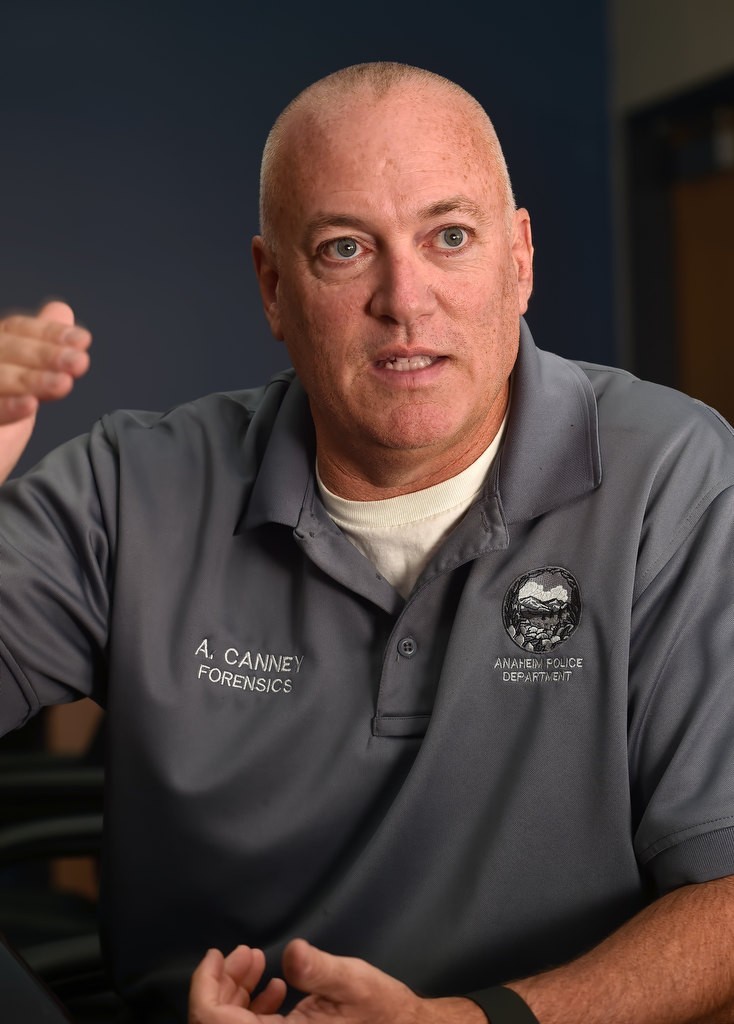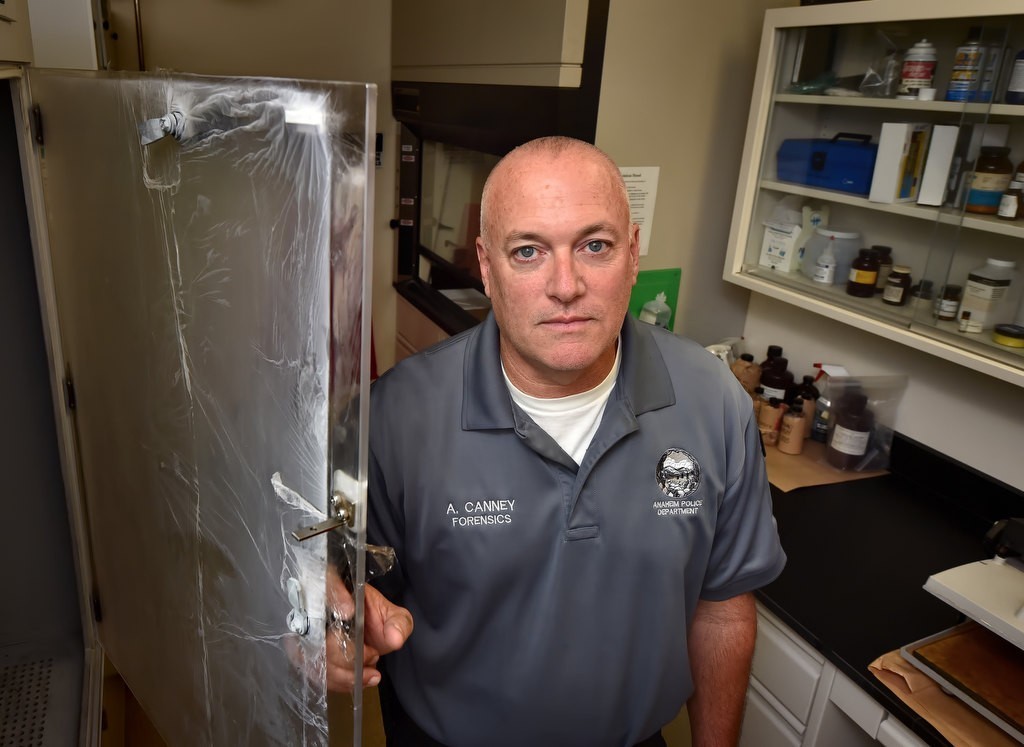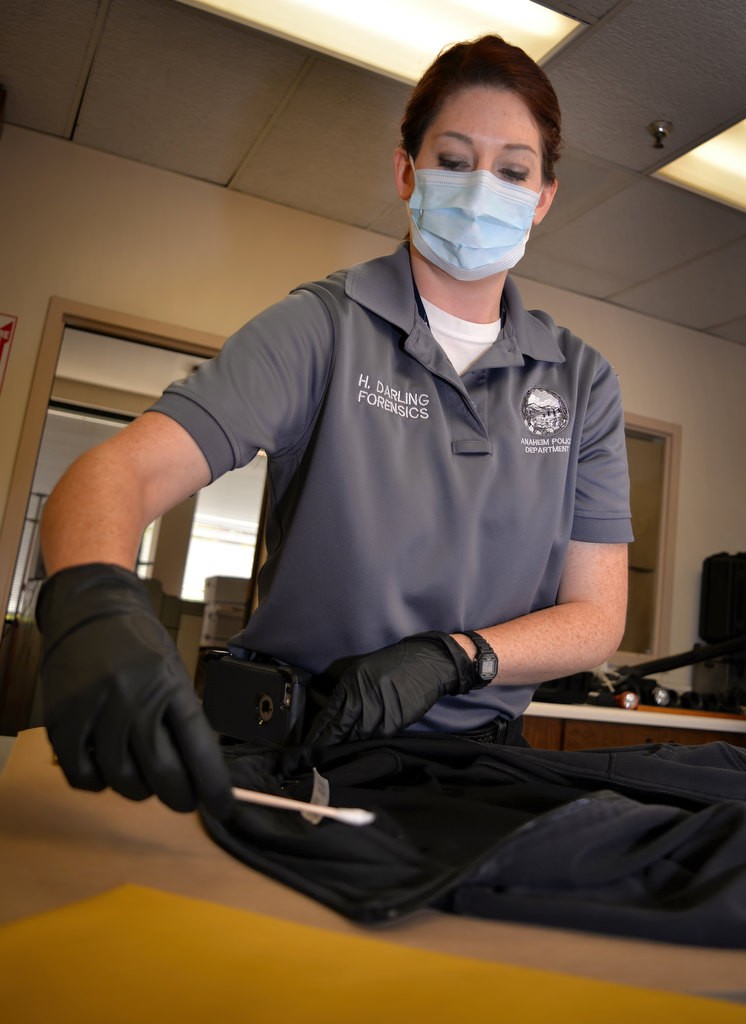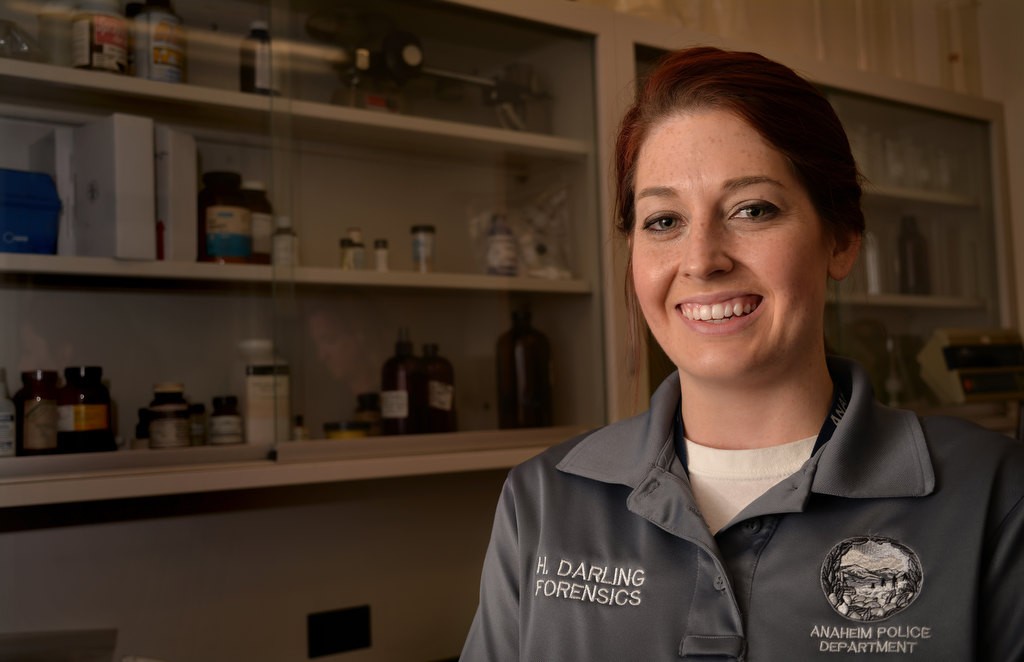Their expertise helps put criminals behind bars.
And they don’t need a gun or a Taser or handcuffs to do it.
Instead, the specialists who work in the Anaheim Police Department’s Forensic Services Unit rely on microscopes and computers, powders and chemicals, freezers and swab dryers — sometimes, even maggot kits.
Simply put, the role of the forensics unit involves collecting and preserving evidence in order to solve crimes.

Hannah Darling made the cut in the highly competitive field of forensic investigations.
Photo by Steven Georges/Behind the Badge OC
They are the unsung heroes of the APD who work alongside patrol officers and investigators, toiling behind the scenes and rarely getting public recognition – even though they play a critical role within the agency, day in and day out.
Their work helps identify the guilty and exonerate the innocent.
“We respond to almost every major crime in this city,” said Drew Canney, who has 24 years of experience as a crime scene investigator and who oversees the unit, which includes eight forensic specialists.
“On TV, they solve major crimes in about an hour,” Canney said. “Well, that’s not the way it works.”

Drew Canney has 24 years of experience in forensics and leads the APD’s Forensic Services Unit. File photo by Steven Georges/Behind the Badge OC
More typical of the cases are ones recently handled by Hannah Darling, who started at the APD in July 2015 after working in the Crime Lab of the Contra Costa County Sheriff’s Department.
One case involved an attempted residential burglary in which the perp never made it inside the house.
The perp did, however, have the courtesy to leave behind a jacket in the backyard.
Darling was able to get a DNA hit after swabbing the inside neckline of the jacket.

Canney: “Most cases in our line of work are solved through databases.” File photo by Steven Georges/Behind the Badge OC
“When I get these (hits), I feel I’m doing a job well done and the system is working,” said Darling, who worked hard to land the highly competitive job at the APD.
Forensic specialists are civilian positions that require a four-year college degree, preferably in chemistry, biochemistry, physics or another hard science. Certifications also help a candidate’s chances of landing a forensics job.
In another of Darling’s recent cases, the twentysomething forensic specialist was able to obtain DNA hits off the interior rim of a baseball cap and the handle of a screwdriver. The bad guy was arrested for stealing copper wires from the roof of a commercial building.
Along with the Santa Ana PD, the Anaheim PD is the only police agency in Orange County that staffs its forensic unit 24/7.

Hannah Darling, a forensic specialist at the Anaheim PD, demonstrates how she would retrieve fingerprints (in this case the photographer’s) from a cup for evidence.
Photo by Steven Georges/Behind the Badge OC
Forensic specialists typically will get called to a crime scene by a detective, Canney said.
It could be to a burglary, to a fatal car accident or to a homicide.
APD homicide detectives work closely with the Forensic Detail.
“We partner with them at crime scenes and collaborate with them on an ongoing basis as an investigation unfolds, often over the course of several months,” Sgt. Jeff Mundy said. “This partnership is so valuable that a detective assigned to work a crime scene will not begin to process it until our Forensic Detail partners are on scene and fully briefed on the circumstances. We move forward as a team, and the forensic specialists are an integral part of that team. Their input and expertise is crucial as detectives try to bring order to chaos.”
When forensic specialists arrive at a scene, they scour the scene, using powders and chemicals to detect latent fingerprints, looking for a hair follicle, nail clipping or shoe impression – evidence that could prove invaluable in determining the identity of a suspect.
Processing, preserving and cataloging the evidence is vital, lest a defense lawyer discredits that evidence in court.
Vials of blood are preserved in a refrigerator.
DNA samples and blood-stained clothing are kept in the freezer.
One useful piece of crime-solving equipment is the unit’s Automated Fingerprint Identification System (AFIS), which uses digital imaging to obtain, store and analyze fingerprint data, Canney said.
A latent print can be compared to a database of prints stored in the AFIS in an effort to find a matching print and ultimately the identity of the suspect.
Said Carrey: “Most cases in our line of work are solved through databases.”
Said Darling of DNA hits: “I really get excited about them.”
Sgt. Mike McAlpine said the APD’s forensics unit is an invaluable resource for all investigations.
“Their work ethic and expertise has led to the successful arrest and prosecution of many career criminals,” McAlpine said. “Some of these cases may have gone unsolved if it wasn’t for their efforts and commitment. We are fortunate here at APD to have a forensics unit, especially one that is talented as they are.”

Hannah Darling, a forensic specialist at the Anaheim PD, demonstrates a method of retrieving DNA evidence.
Photo by Steven Georges/Behind the Badge OC
 Behind the Badge
Behind the Badge




